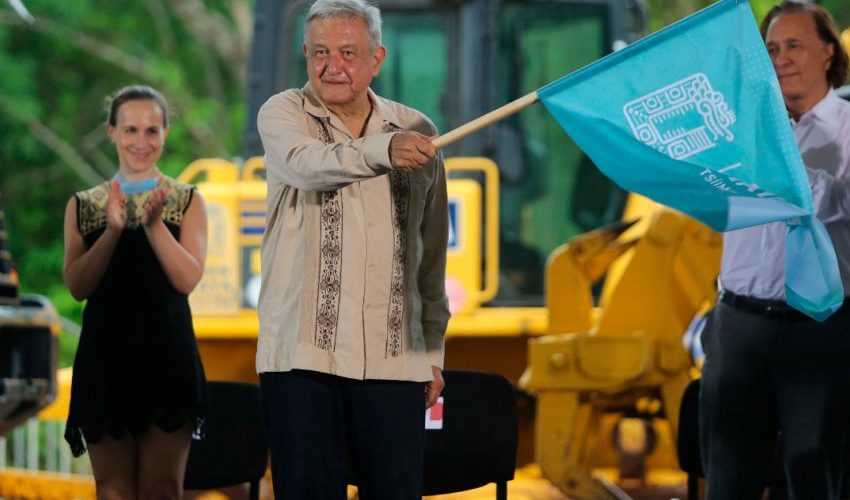
LÁZARO CÁRDENAS, Quintana Roo – President Andrés Manuel López Obrador gave the flag this Monday at the start of the construction of the Maya Train, one of his flagship projects, between the economic and social reopening after the COVID-19 pandemic and the rejection of indigenous communities.
Despite the fact that the coronavirus is in its maximum contagion stage -with more than 93,435 confirmed patients and almost 10,167 deaths- López Obrador resumed his tours after the April strike, to inaugurate the works of the railway that will travel through the southeast of Mexico and in the one who hopes to create thousands of jobs to contain the current crisis.
“This work has to be completed in 28 months,” said López Obrador in his opening speech. He added that he will not accept any kind of an excuse “we have to finish on time and on a budget”.
The start of the work occurred in section 4 Izamal-Cancun, in the Lázaro Cárdenas municipality of the state of Quintana Roo, which will be about 260 kilometers (161 miles) with an investment of around 27,000 million pesos (about $ 1,225 million).
He said that the company Ingenieros Civiles Asociados (ICA), in charge of the work, has to comply with the schedule “in time and budget because there will be no expansion.”
“The project is very ambitious and will change the face of the region,” said the director of ICA, Guadalupe Phillips, since it will allow two communication channels, the railroad, and the highway, to coexist, as happens in many countries of the world.
The president disqualifies press reports on deaths and hospital crises.
The 1,475-kilometer (916-mile) railway megaproject, which will traverse five entities in southeastern Mexico, is, together with the Santa Lucía Airport in the State of Mexico and the Dos Bocas Refinery, in Tabasco, the flagship projects in the infrastructure of the López Obrador government.
WEEK IN THE SOUTHEAST
The Mexican president announced that in the following days he will do the same in the sections of the train in the states of Yucatan, Campeche, Tabasco, and Chiapas.
The sections to be inaugurated are those of Palenque-Escárcega, Escárcega-Campeche, Campeche-Mérida and Mérida-Cancún, which together with the fifth section Cancún-Tulum, covers some 1,000 kilometers (621 miles) of railways.
According to Mexican government estimates, the project will create about 80,000 jobs in these five sections at the start of work and for next year there will be 154,000 jobs.
In addition, for this year contracts for 90,000 million pesos ($ 4,083 million) have been authorized.
“It is the most important federal public investment that has been seen in many years in the southeast,” the president said Monday morning.
The Mexican president said things are not so bad compared to other countries.
He recalled that four sections have been tendered and this month the fifth (Cancun-Tulum) will be tendered and the Tulum-Escárcega section, which has the Tulum-Carrillo Puerto, Bacalar-Chetumal, Xpujil-Calakmul links and back to Escárcega with which the circuit of 1,500 kilometers (932 miles) will be closed.
He said that this construction would be in charge of the Army, of the military engineers, who, finishing the New Mexico City Airport, Felipe Ángeles, which is going to open on March 21, 2022, will take over the train.
According to López Obrador, the plan is to open the train in 2023 in the five sections Palenque, Campeche, Yucatán, Cancún, Tulum and in 24 the two sections of Tulum-Carrillo Puerto-Escárcega.
A MILLION JOBS
According to the director general of the National Fund for Tourism Promotion (Fonatur), Rogelio Jiménez Pons and head of the project, the influence of the train on land use in the region “will be decisive.”
“The Mayan Train will take care of the environment, improve cities and distribute the benefits of growth,” said the manager, in line with a report by UN-Habitat, the United Nations program for human settlements.
A week ago, the agency noted that the Maya Train will generate almost a million new jobs and lift more than a million people out of poverty in southeastern Mexico.
In mid-May, environmental, indigenous and civil organizations asked the Inter-American Commission on Human Rights (IACHR) to take precautionary measures to “avoid irreparable damage” to the underground aquifer of the Yucatan Peninsula, southeast of Mexico, in the face of possible damage that would cause the construction of the Maya Train megaproject.
They noted that the aquifer is an “indispensable element” of the territories and the main source of water supply for the population and the communities of the Mayan people.
Therefore, in the application of the precautionary principle in environmental matters, they requested that the Mexican State refrain from building the Maya Train for the “serious and irreparable damage that this might cause to the aquifer.”
Source: https://www.explica.co/amlo-marks-the-start-of-the-mayan-train-between-pandemic-and-rejection/
